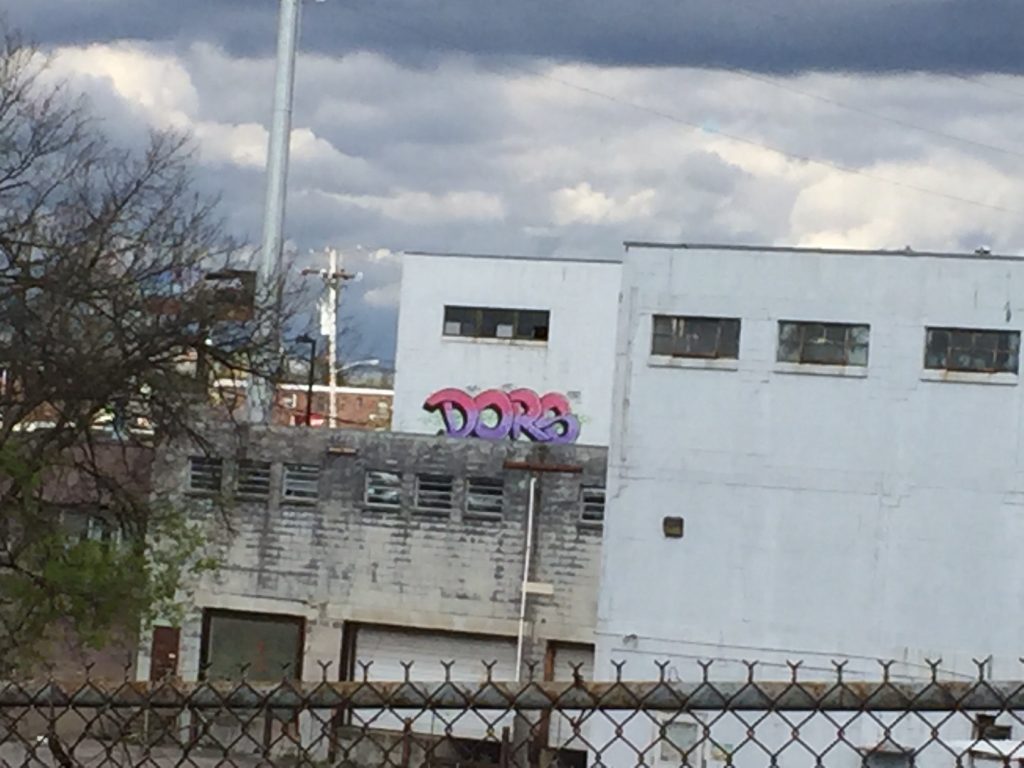Every artist wants their work to be seen, right? Actually if there’s one thing I’ve learned after years of studying art it’s that the one thing that’s true of art is there are no absolutes. There are artists who work in silence, who work only for themselves, creating works that may not be found until after their deaths—obvious examples being Van Gogh who only sold a couple of paintings in his lifetime and for the most part wasn’t trying to please anybody but himself, and Emily Dickinson who, although she tried to publish a handful of poems, did most of her work in private.
And at the other end of the spectrum there are artists who deliberately seek fame and attention; although this is largely a modern phenomenon there have probably always been artists who courted the rich and powerful, even if it meant doing the bidding of the king and his court.
One of the interesting things to me about graffiti is it seems to fall somewhere in between. Artists create works that are publicly visible but they’re usually very personal. Take this, for instance.
 Yes, there are a lot of layers to “very personal” art. No artist, no matter how personal their art, is working in a vacuum. They’re influenced by other artists, by history, by the world around them, and by myriad other factors. Why’d you choose that design? It’s sort of what other people do. Why’d you choose that color? Maybe it was all that was available. In fact there have been fads for certain colors because they became available—blue began to appear more in 19th century Japanese prints, for instance, because of the discovery of a new blue pigment, but that’s another story. Every work of art represents a number of choices, but only some of those choices are deliberate on the artist’s part—there are also a lot that are made by circumstances.
Yes, there are a lot of layers to “very personal” art. No artist, no matter how personal their art, is working in a vacuum. They’re influenced by other artists, by history, by the world around them, and by myriad other factors. Why’d you choose that design? It’s sort of what other people do. Why’d you choose that color? Maybe it was all that was available. In fact there have been fads for certain colors because they became available—blue began to appear more in 19th century Japanese prints, for instance, because of the discovery of a new blue pigment, but that’s another story. Every work of art represents a number of choices, but only some of those choices are deliberate on the artist’s part—there are also a lot that are made by circumstances.
To get back to my point about artists wanting their work to be seen, though, here’s a broader view of where that piece is located.
 The work is pretty large and the artist deliberately placed it high on a building on Nashville’s Charlotte Avenue, which is a major street with lots of traffic. But it’s placed on the side of the building, facing a side street that most people won’t take unless they live in the neighborhood or take a wrong turn. And even then you really have to be standing in just the right spot to see it. One of the reasons I didn’t get a closer picture, aside from all the NO TRESPASSING signs and fences and some guy looking at me suspiciously, is I couldn’t see a way to get closer and still be able to see the work, aside from climbing up on the building, and maybe I should have asked that guy, “Hey, could you give me a leg up here, and maybe also a ladder?”
The work is pretty large and the artist deliberately placed it high on a building on Nashville’s Charlotte Avenue, which is a major street with lots of traffic. But it’s placed on the side of the building, facing a side street that most people won’t take unless they live in the neighborhood or take a wrong turn. And even then you really have to be standing in just the right spot to see it. One of the reasons I didn’t get a closer picture, aside from all the NO TRESPASSING signs and fences and some guy looking at me suspiciously, is I couldn’t see a way to get closer and still be able to see the work, aside from climbing up on the building, and maybe I should have asked that guy, “Hey, could you give me a leg up here, and maybe also a ladder?”
There are a lot of reasons the artist probably chose that exact spot—most of them not really choices but rather a matter of circumstances, but I like to think there was some intention there, that the answer to, “Why’d you choose that spot?” would be, “Because I wanted people to make an effort to see it.”
Now here’s an Emily Dickinson poem.
#930
The Poets light but Lamps —
Themselves — go out —
The Wicks they stimulate
If vital Light
Inhere as do the Suns —
Each Age a Lens
Disseminating their
Circumference —






I love seeing your graffiti pictures and hearing your thoughts on art. I always imagined Nashville to be a vibrant, affluent place but some of your pictures show a different story. Is it because you are drawn to more barren areas of Nashville where graffiti may be more prevalent or am I wrong in thinking Nashville is a shiny, vibrant place?
Your thoughts on artists wanting their work to be seen or not is interesting. As a developing artist bumbling along doing my own thing, i used to find it really hard to let anyone see anything I did because it was so personal. But I gradually went from that to being able to freely share my work online or in exhibitions with no concern about being judged. What does it matter? People will either like what we do or they won’t. Or, they may have no opinion at all. But I will never stop enjoying what I do regardless of what anyone thinks because it is the process I enjoy, not the end product. Creating with colour is more powerful than meditation for me.
Nashville really is a shiny, vibrant place, but every city has its seedy underside. I’m also old enough to remember when Nashville had a seedy overside, but that’s another story. The really interesting thing about the particular spot where I found this particular graffiti is that the area around it is undergoing terrific redevelopment at the moment. There are new restaurants and shops coming in and there’s a very nice shiny new apartment building, although it’s placed next to train tracks. And the apparently abandoned industrial lot where I found this graffiti is on the other side of the tracks–literally the “wrong” side of the tracks. In the midst of all that’s shiny and new is this which some people might call an eyesore. There’s a larger metaphor in that–several metaphors, really.
Anyway I’m glad you’ve been able to show your work publicly. I know just creating is therapeutic, even if it’s just for yourself, but it can also be a real boost to have people like something you’ve made.
I want my work to be seen, Chris, and I am influenced by many others, including you and Emily Dickinson.
I have seen your comment here and your work elsewhere, and I am glad for it.